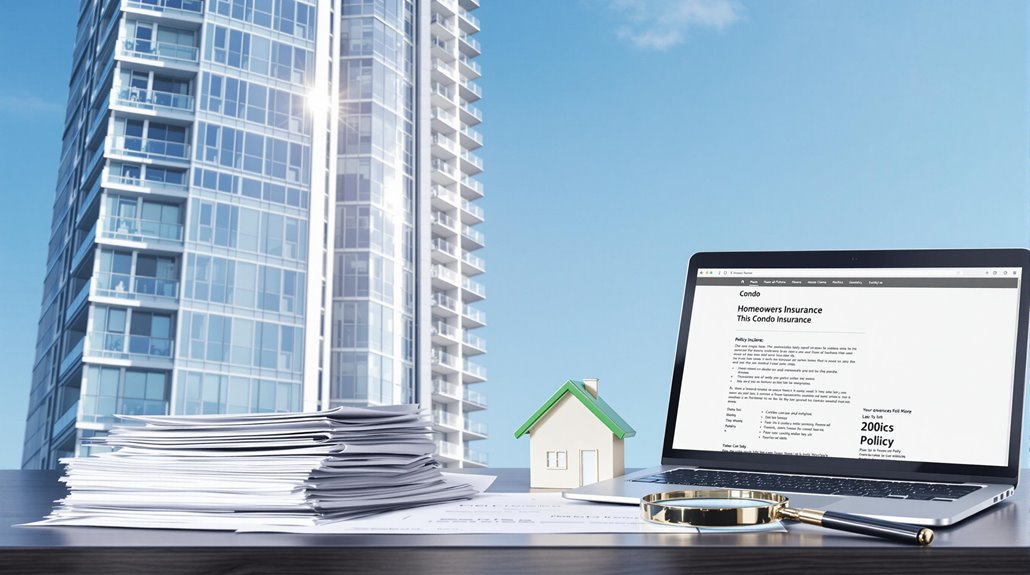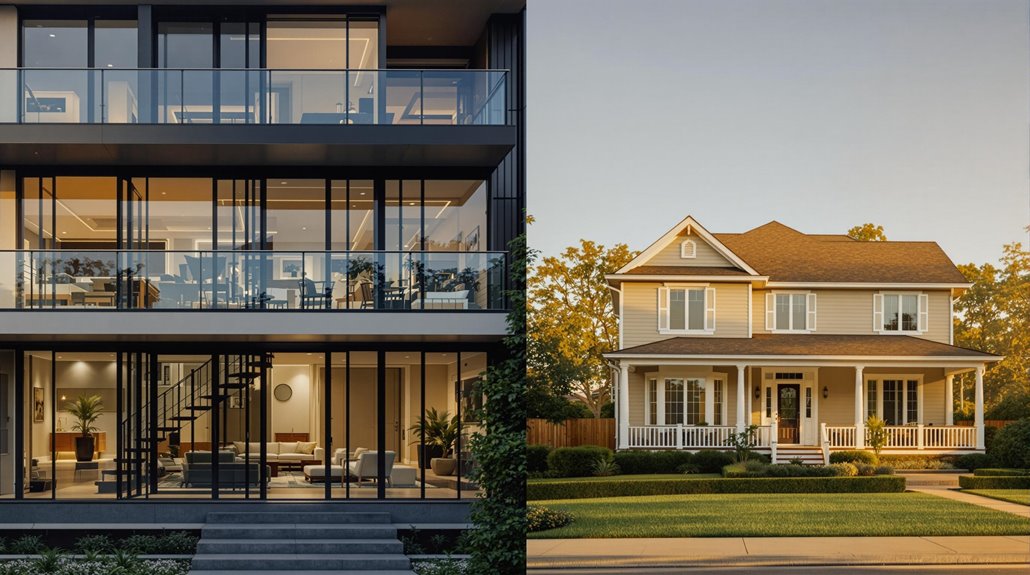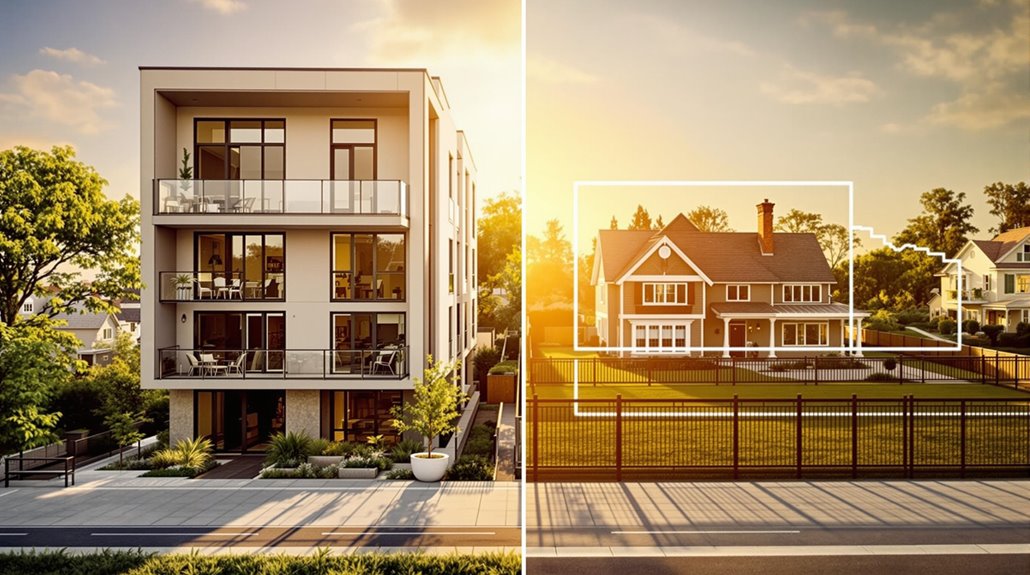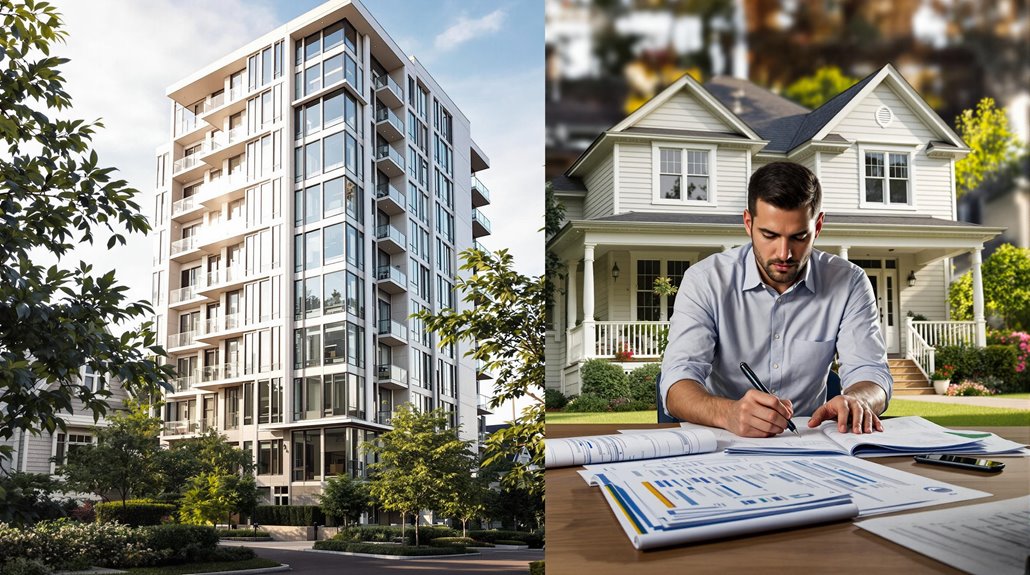Homeowners insurance (HO3) and condo insurance (HO6) differ greatly in coverage and cost. HO3 policies protect the entire structure and property, averaging $1,754 annually, while HO6 policies focus on unit interiors and personal belongings, averaging $506 annually. Condo insurance works in conjunction with the association's master policy, which covers common areas and external structures. Understanding the interplay between these policies guarantees proper protection and prevents coverage gaps.
Key Takeaways
- Homeowners insurance covers the entire structure and property, while condo insurance primarily protects interior spaces and personal belongings.
- Annual premiums differ significantly: homeowners insurance averages $1,754, whereas condo insurance costs around $506.
- Condo insurance works alongside a master policy provided by the association, while homeowners insurance operates as standalone coverage.
- Liability coverage is more extensive in homeowners insurance due to greater property responsibility and increased risks.
- Condo owners need loss assessment coverage to protect against master policy shortfalls, which isn't necessary for homeowners.
Understanding Coverage Differences Between HO3 and HO6 Policies
When purchasing property insurance, understanding the fundamental differences between HO3 and HO6 policies is essential for making an informed decision.
HO3 homeowners insurance policy provides extensive coverage for the entire structure, including both exterior and interior elements of a single-family home, along with personal property and liability protection for the whole property.
In contrast, condo insurance policies (HO6) focus specifically on unit owners' needs, covering the interior space and personal property within the condominium.
The master policy held by the condo association typically handles the building structure and common areas.
HO6 policy coverage supplements this by protecting unit-specific improvements and providing liability coverage for incidents within the unit.
Due to this more limited scope, condo insurance generally costs less, with average annual premiums of $506 compared to $1,754 for homeowners insurance coverage.
Master Policy Impact on Individual Coverage Needs

The master policy provided by a condo association serves as the foundation for determining individual unit owners' insurance needs.
Understanding whether the condo associations master policy is bare walls, single entity, or all-in coverage directly influences the amount of dwelling coverage required in an individual condo insurance policy.
Master policy coverage protects common areas and building structures, but typically excludes personal belongings inside units and owner improvements.
To prevent financial loss, unit owners must carefully review the condo associations master policy to identify coverage gaps.
Individual condo insurance fills these gaps through HO-6 policies, which provide protection where the master policy ends.
Unlike traditional homeowners insurance, condo coverage requires a nuanced understanding of the interplay between master and individual policies.
This knowledge guarantees adequate protection for interior fixtures, personal property, and liability exposure, preventing potentially costly coverage oversights.
Property Protection: Inside and Outside the Walls

Property protection represents a fundamental distinction between condo and homeowners insurance policies, with each type providing coverage tailored to specific ownership structures. Homeowners insurance offers extensive dwelling coverage that encompasses both interior and exterior elements of a single-family home, while condo insurance focuses primarily on "walls-in" protection.
The interplay between condo associations insurance and individual coverage creates a unique framework for property protection. While the master policy typically covers common areas and building exteriors, unit owners must secure personal property coverage and protection for interior improvements through HO-6 policies.
This division of responsibility is reflected in the significant cost difference, with homeowners insurance averaging $1,754 annually compared to $506 for condo insurance. To avoid coverage gaps, condo owners must carefully review their master policy details to guarantee adequate protection for their unit's interior elements, including walls, floors, and personal belongings.
Liability and Loss Assessment Coverage Explained

Understanding liability and loss assessment coverage reveals significant differences between condo and homeowners insurance policies.
While homeowners insurance provides extensive liability coverage for the entire property, condo insurance focuses primarily on protecting unit owners against claims arising within their individual units.
Personal liability coverage in both types of policies encompasses legal fees, medical payments, and damages awarded to injured parties.
However, homeowners insurance typically requires higher liability limits due to the increased risks associated with full property ownership.
Condo insurance includes a unique feature called loss assessment coverage, which protects unit owners when the association's master policy falls short of covering a claim.
For condo owners, understanding these distinctions is important, as liability for common areas typically falls under the association's master policy.
This separation of responsibility makes it essential for unit owners to maintain adequate coverage while recognizing the boundaries between personal and association liability protection.
Cost Factors and Premium Considerations

When comparing insurance costs between condos and single-family homes, premiums reveal substantial differences in both price points and contributing factors. Homeowners insurance averages $1,754 annually, while condo insurance typically costs $506 per year. This significant disparity stems from the scope of coverage, as condo insurance primarily protects the unit's interior and personal property, while homeowners insurance covers the entire structure.
Key cost factors that influence insurance premiums include:
- Property characteristics – square footage, building age, and location
- Selected coverage options – personal property limits and liability coverage amounts
- Available discounts – bundling opportunities with other insurance policies
Insurance providers evaluate these elements when determining premium costs for both types of coverage.
Property owners can optimize their expenses by carefully selecting appropriate coverage limits and taking advantage of discount bundling opportunities while maintaining adequate protection for their specific needs.
The Benefits Of Consulting A Public Adjuster

Public adjusters provide essential expertise in guiding both condo and homeowners insurance claims, offering objective damage assessments that guarantee all losses are properly documented and valued.
Their professional involvement streamlines the claims process by handling documentation, negotiations, and settlement discussions with insurance carriers.
Studies indicate that policyholders who engage public adjusters typically receive notably higher claim settlements, often justifying the adjuster's contingency fee through enhanced payouts.
Expertise In Insurance Claims
Maneuvering the complexities of insurance claims can be overwhelming for property owners, which is why consulting a public adjuster often proves invaluable. Their expertise in managing insurance policies and negotiations with insurance companies typically results in settlements 20% to 50% higher than those handled independently.
Public adjusters bring essential value through:
- Extensive understanding of policy coverage and identification of eligible claims
- Professional documentation and presentation of damages to maximize settlement potential
- Direct communication with insurance companies, saving policyholders time and reducing stress
Their specialized knowledge enables thorough claim evaluations, ensuring no coverage opportunities are missed.
Objective Damage Assessment
An objective damage assessment stands at the heart of any successful insurance claim, and engaging a public adjuster elevates this critical process.
Whether dealing with condo insurance or homeowners insurance claims, public adjusters provide thorough, unbiased evaluations of property damage and losses.
These professionals meticulously handle damage documentation, ensuring every detail is captured and properly valued. Their expertise in insurance policies enables them to conduct extensive coverage assessments, often identifying benefits that policyholders might otherwise miss.
Working independently from insurance companies, public adjusters advocate solely for the policyholder's interests, leading to more accurate claim valuations. This objective approach helps maximize insurance claims, particularly in complex situations where damage extent may be disputed.
Their systematic evaluation process supports stronger negotiating positions and typically results in more favorable settlement outcomes.
Streamlined Claim Process
When maneuvering the complex world of insurance claims, engaging a public adjuster can transform a potentially overwhelming process into a streamlined experience.
Whether dealing with condo insurance or homeowners insurance claims, these professionals work exclusively for the policyholder, ensuring their interests remain paramount throughout the settlement process.
- Public adjusters expertly interpret policy coverage and document damages extensively, often securing 20-50% higher settlements than self-managed claims.
- Unlike insurance adjusters who represent the insurance company, public adjusters focus solely on maximizing the policyholder's claim value.
- While charging a percentage of the settlement, their expertise in negotiations and claims process management typically results in higher payouts that offset their fees.
The professional guidance provided by public adjusters allows property owners to focus on recovery while ensuring thorough claim representation.
Higher Claim Payouts & Settlements
Three compelling advantages emerge when consulting a public adjuster for insurance claims: enhanced settlement amounts, expert damage assessment, and skilled negotiation tactics. Studies indicate that policyholders partnering with public adjusters consistently secure 20% to 50% higher claim payouts compared to self-managed claims. Operating on a contingency basis, these professionals are motivated to maximize settlements while managing the complex claims process.
| Benefit | Impact |
|---|---|
| Settlement Size | 20-50% Higher Payouts |
| Time Management | Reduced Paperwork Burden |
| Expertise | Professional Damage Assessment |
| Negotiation | Skilled Insurance Company Interface |
For condo owners and homeowners facing significant damage from water or fire losses, public adjusters' understanding of policy coverage proves invaluable during recovery, ensuring ideal compensation while allowing clients to focus on restoration rather than administrative complexities.
About The Public Claims Adjusters Network (PCAN)

The Public Claims Adjusters Network (PCAN) stands as a nationwide organization of vetted, state-licensed public adjusters who assist policyholders with residential and commercial property damage claims. This expert network maintains rigorous standards for membership, requiring adjusters to complete an intensive application and interview process before acceptance.
Key aspects of PCAN include:
- Coverage across 40+ states with expertise in over 30 different types of insurance claims
- Mandatory annual audits of licenses and complaint records to guarantee continued excellence
- Pre-vetted professionals who meet the highest ethical and professional standards
PCAN serves as a valuable resource for policyholders seeking qualified representation for their insurance claims. The organization connects property owners with top-tier public adjusters who have demonstrated exceptional expertise in their field.
Through strict vetting processes and ongoing oversight, PCAN guarantees its member adjusters maintain the highest levels of professional conduct and technical competence.








